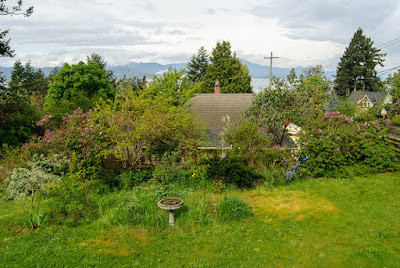 |
| In 2002, I was dreaming of transforming this section of our Saltspring Island property into an English country garden paradise. All photos by John Denniston. |
 |
| By 2022, it looked pretty lush, with a weeping silver pear to the left, roses to the left and centre front and California lilacs to the centre and right. But you don't want to know what was growing in the jungle underneath. |
 |
| In early 2023, John took a weed-whacker and mattock to the jungle, clearing the way for some new plants. |
Oh, it was
the chance of a lifetime! From a shady garden in Vancouver to a sunny one in
Saltspring with plenty of room for every plant I’d ever fantasized about.
And so, a
silver weeping pear (as seen in all the best English gardens!), a “golden” mock
orange, a hardy rugosa rose, a delicately pink magnolia, two California lilacs,
and a pink lavatera were among the treasures I lovingly dug into our Saltspring
property 20 years ago. Plus, at least at
first, flats of home-started seedlings of all kinds of colourful sun-loving annuals
and perennials.
Well,
things wax and wane over the years, and I learned that sporadic maintenance of
a dry, hot garden has its costs. The magnolia died quite soon, the mock orange
struggled and the lavatera scraggled. The spreading rose moved in on the
weeping pear with deadly intent, and while the California lilacs grew and grew,
large dead brown spots appeared. The sun-loving flowers, both annuals and perennials,
vanished after a season.
After
awhile, that dreamed-of garden turned into a jungle of tall grasses, English
ivy, periwinkle, blackberries, and fast-propagating mystery trees with cruel
thorns. I was grateful to see occasional sparks of colour from the lavatera and roses, but chose
not to look too closely at what was happening underneath all that.
Which brings
us to this year, when a friend offered us some plants from her Saltspring
garden. “Do you have space?” she asked.
A little
ashamed of our neglect in the face of her new-gardener’s enthusiasm, we began
delving into the undergrowth, me with a garden fork, John with a weed-whacker and mattock. We
discovered the California lilacs, planted as shrubs, had become huge trees with
massive trunks, oddly contorted because of their struggles with the undergrowth.
The pear had survived, but competition from the roses had killed off branches
on one side, leaving it asymmetrical. Dry sticks of lavatera poked up from
roots that still had some life to them.
Once the
jungle was cleared away, we could see once more where we’d started 20 years
ago. There was room for the new plants, which are tough ones suitable for island
conditions. We dug them in, wishing them well against the competition coiled in
the ground all around them.
Sadder but wiser, we have no more illusions that
our garden will ever be a slice of English-country paradise.
 |
| The garden in 2004... |
 |
| ...in 2007... |
 |
| ...in 2009... (we'd obviously been away for awhile, but notice the regular lilac to the left in full bloom) |
 |
| ...in 2014... |
 |
| ...in 2017... (once again, the garden is overgrown, but this time the pink lavatera is thriving to the right front.) |
 |
| Earlier this year, a good clear-out of the undergrowth exposed full-grown California lilacs. |
 |
| One was badly contorted by the tough life it's led in the undergrowth. |
 |
| Back
to shovels and bags of fresh soil. Let's see how tough these new plants are! |











No comments:
Post a Comment